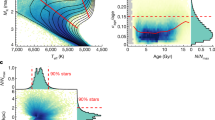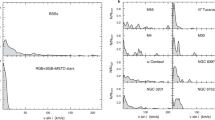Abstract
The first stars that formed after the Big Bang were probably massive1, and they provided the Universe with the first elements heavier than helium (‘metals’), which were incorporated into low-mass stars that have survived to the present2,3. Eight stars in the oldest globular cluster in the Galaxy, NGC 6522, were found to have surface abundances consistent with the gas from which they formed being enriched by massive stars4 (that is, with higher α-element/Fe and Eu/Fe ratios than those of the Sun). However, the same stars have anomalously high abundances of Ba and La with respect to Fe4, which usually arises through nucleosynthesis in low-mass stars5 (via the slow-neutron-capture process, or s-process). Recent theory suggests that metal-poor fast-rotating massive stars are able to boost the s-process yields by up to four orders of magnitude6, which might provide a solution to this contradiction. Here we report a reanalysis of the earlier spectra, which reveals that Y and Sr are also overabundant with respect to Fe, showing a large scatter similar to that observed in extremely metal-poor stars7, whereas C abundances are not enhanced. This pattern is best explained as originating in metal-poor fast-rotating massive stars, which might point to a common property of the first stellar generations and even of the ‘first stars’.
This is a preview of subscription content, access via your institution
Access options
Subscribe to this journal
Receive 51 print issues and online access
$199.00 per year
only $3.90 per issue
Buy this article
- Purchase on Springer Link
- Instant access to full article PDF
Prices may be subject to local taxes which are calculated during checkout


Similar content being viewed by others
Change history
08 June 2011
Errors in Table 1 have been corrected in the HTML and PDF and described in the accompanying Corrigendum.
References
Bromm, V., Yoshida, N., Hernquist, L. & McKee, C. The formation of the first stars and galaxies. Nature 459, 49–54 (2009)
Truran, J. W. A new interpretation of the heavy element abundances in metal-deficient stars. Astron. Astrophys. 97, 391–393 (1981)
Cowan, J. J. & Sneden, C. Heavy element synthesis in the oldest stars and the early Universe. Nature 440, 1151–1156 (2006)
Barbuy, B. et al. VLT-FLAMES analysis of eight giants in the bulge metal-poor globular cluster NGC 6522: oldest cluster in the Galaxy? Astron. Astrophys. 507, 405–415 (2009)
Sneden, C., Cowan, J. J. & Gallino, R. Neutron-capture elements in the early Galaxy. Annu. Rev. Astron. Astrophys. 46, 241–288 (2008)
Pignatari, M. et al. The s-process in massive stars at low metallicity: the effect of primary 14N from fast rotating stars. Astrophys. J. 687, L95–L98 (2008)
Frebel, A. Stellar archaeology: exploring the Universe with metal-poor stars. Astron. Nachr. 331, 474–488 (2010)
Beers, T. C. & Christlieb, N. The discovery and analysis of very metal-poor stars in the Galaxy. Annu. Rev. Astron. Astrophys. 43, 531–580 (2005)
Martayan, C. et al. Be stars and binaries in the field of the SMC open cluster NGC 330 with VLT-FLAMES. Astron. Astrophys. 472, 577–586 (2007)
Hirschi, R. Very low-metallicity massive stars: pre-SN evolution and primary nitrogen production. Astron. Astrophys. 461, 571–583 (2007)
Ekström, S., Meynet, G., Chiappini, C., Hirschi, R. & Maeder, A. Effects of rotation on the evolution of primordial stars. Astron. Astrophys. 489, 685–698 (2008)
Meynet, G., Ekström, S. & Maeder, A. The early star generations: the dominant effect of rotation on CNO yields. Astron. Astrophys. 447, 623–639 (2006)
Frischknecht, U., Hirschi, R., Meynet, G., Ekstroem, S., Georgy, C., Rauscher, T., Winteler, C. & Thielemann, F.–K. Constraints on rotational mixing from surface evolution of light elements in massive stars. Astron. Astrophys. 522, A39 (2010)
Bisterzo, S. et al. s-process in low metallicity stars – I. Theoretical predictions. Mon. Not. R. Astron. Soc. 404, 1529–1544 (2010)
Karakas, A. I. Updated stellar yields from asymptotic giant branch models. Mon. Not. R. Astron. Soc. 403, 1413–1425 (2010)
Qian, Y.-Z. & Wasserburg, G. J. Abundances of Sr, Y and Zr in metal-poor stars and implications for chemical evolution in the early Galaxy. Astrophys. J. 687, 272–286 (2008)
Farouqi, K. et al. Nucleosynthesis modes in the high-entropy wind of type II supernovae: comparison of calculations with halo-stars observations. Astrophys. J. 694, L49–L53 (2009)
Travaglio, C. et al. Galactic evolution of Sr, Y, and Zr: a multiplicity of nucleosynthetic processes. Astrophys. J. 601, 864–884 (2004)
Chiappini, C. et al. A strong case for fast stellar rotation at very low metallicities. Astron. Astrophys. 449, L27–L30 (2006)
Chiappini, C. et al. A new imprint of fast rotators: low 12C/13C ratios in extremely metal-poor halo stars. Astron. Astrophys. 479, L9–L12 (2008)
Stacy, A., Bromm, V. & Loeb, A. Rotation seed of the first stars. Mon. Not. R. Astron. Soc. (in the press)
Acknowledgements
C.C., U.F., G.M., T.D. and A.M. acknowledge support from the Swiss National Science Foundation (SNSF). M.P. acknowledges support from an Ambizione grant from the SNSF, and from NSF grant PHY 02-16783 (Joint Institute for Nuclear Astrophysics, JINA). B.B. acknowledges support from FAPESP and CNPq (Brazil). C.C. and T.D. acknowledge partial support from ESF-EuroGENESIS. R.H. acknowledges support from the World Premier International Research Center Initiative (WPI Initiative), MEXT, Japan. This work is based on observations collected at the European Southern Observatory (ESO).
Author information
Authors and Affiliations
Contributions
C.C. led the analysis and the write-up of the paper. U.F., R.H., G.M. and A.M. computed the new stellar evolution models. B.B. measured the chemical abundances. T.D. and M. P. contributed to the analysis. All authors contributed to the analysis and text writing.
Corresponding author
Ethics declarations
Competing interests
The authors declare no competing financial interests.
Supplementary information
Supplementary Information
This file contains Supplementary Text, additional references and Supplementary Figures 1-4 with legends. (PDF 315 kb)
PowerPoint slides
Rights and permissions
About this article
Cite this article
Chiappini, C., Frischknecht, U., Meynet, G. et al. Imprints of fast-rotating massive stars in the Galactic Bulge. Nature 472, 454–457 (2011). https://doi.org/10.1038/nature10000
Received:
Accepted:
Published:
Issue Date:
DOI: https://doi.org/10.1038/nature10000
This article is cited by
-
Fragmentation and correlations in a rotating Bose–Einstein condensate undergoing breakup
Scientific Reports (2023)
-
Origin of the elements
The Astronomy and Astrophysics Review (2023)
-
Modelling the chemical evolution of the Milky Way
The Astronomy and Astrophysics Review (2021)
-
Reconnection Diffusion in Turbulent Fluids and Its Implications for Star Formation
Space Science Reviews (2014)
Comments
By submitting a comment you agree to abide by our Terms and Community Guidelines. If you find something abusive or that does not comply with our terms or guidelines please flag it as inappropriate.



